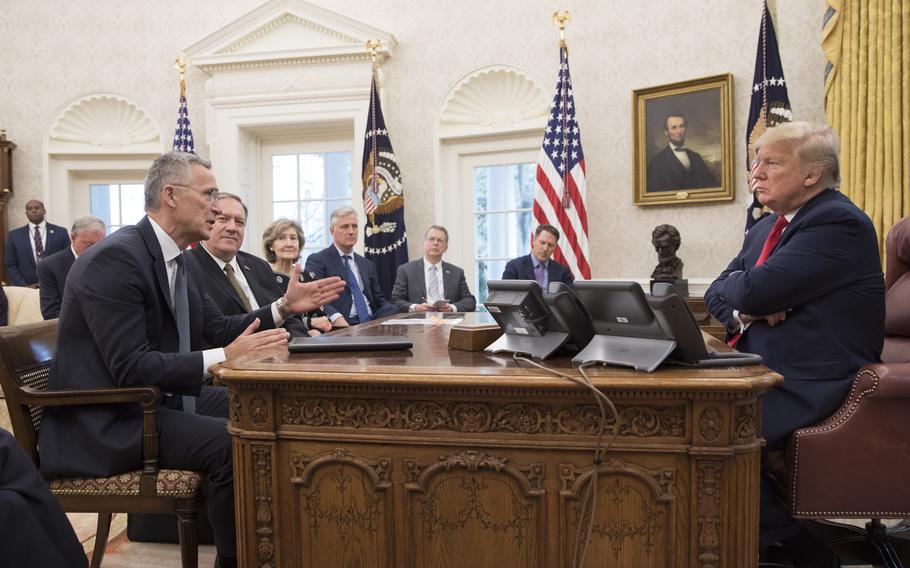
NATO Secretary-General Jens Stoltenberg, left, meets with then-President Donald Trump at the White House in 2019. During a campaign speech Feb. 10, 2024, Trump said he would encourage Russia to attack NATO allies that aren't spending enough on their own defense. (NATO)
Donald Trump said over the weekend that he would encourage Russia to attack “delinquent” NATO allies that, in his judgment, spend too little on defense.
His remarks shocked leaders on both sides of the Atlantic — and mischaracterized how the 31-member alliance works.
NATO member nations all make payments to cover the operating expenses of the organization, which was founded in the aftermath of World War II to help Western Europe counter the Soviet Union with help from Canada and the United States. But they don’t pay membership fees to remain in the alliance, so there’s no delinquency to speak of.
Countries do, however, commit to spending at least 2% of their gross domestic product (GDP) on defense each year, with the goal of ensuring the alliance’s military readiness and deterring any potential attacks. The commitment is a guideline, not a requirement, that has been in place for nearly two decades.
Last year, 11 countries met or exceeded that target, according to NATO statistics. The rest spent smaller portions of their GDP on defense. (Iceland, the only member state with no armed forces, is omitted from the data set.)
Most of the countries that spent beyond the 2% mark either share a border with Russia or sit near the front lines of the Ukraine war. Trump’s insinuation that they’re not paying their share is false.
Poland — which shares part of its northern border with the Russian exclave of Kaliningrad and a long stretch of its southeastern border with Ukraine — spent a greater share of its GDP on defense last year than any other member state, at 3.9%.
The United States ranked second, at 3.49%. But in raw numbers, the $860 billion U.S. defense budget is more than double that of all other NATO allies combined.
Other member states spending more than 2% of their GDP include Estonia, Lithuania, Romania and NATO’s newest member, Finland, which joined the alliance last year. (It’s worth noting that most of the big spenders have national laws or policies that require 2% defense spending in accordance with NATO’s goals.)
Countries farther from Russia were more likely to spend below the 2% guideline. Some — including Germany, Italy and Canada — spent considerably under that target, despite having large economies and GDPs topping $1 trillion. Others, such as Luxembourg, may struggle to meet the threshold because of the limited size of their militaries and defense industries.
Most NATO allies are spending a greater share of their GDP on defense than they were in 2014. That year, Russia invaded the Crimean Peninsula and annexed it, inflaming tensions in Eastern Europe and prompting NATO to double down on its 2% spending goal.
At the time, only three allies were meeting that target. The number increased to seven in 2022. After Russia invaded Ukraine in February of that year, defense spending spiked in several countries.
Poland again topped the list, with its defense spending jumping from 2.4% of its GDP to 3.9%. In total, Poland spent more than $29 billion on defense last year, nearly $12 billion more than it spent in 2022 and three times what it spent a decade ago. France, Slovakia, Hungary and several others also ratcheted up defense spending after the Russian invasion.
Earlier this year, Turkey voted in favor of Sweden’s membership after months of delay. Pending Hungary’s ratification, Sweden is expected to join NATO this year as the 32nd member, and has committed to spending 2.1% of its GDP.
Some member states are spending more but have yet to exceed the 2% mark. Others have flatlined. But the pressure to ramp up defense spending hasn’t gone unnoticed.
Following Trump’s remarks, German Chancellor Olaf Scholz on Monday pledged to meet NATO’s 2% goal. “That is urgently needed,” Scholz said. “Because as harsh as this reality is, we do not live in times of peace.”